




When you do a load of laundry, the last thing you want is to find stains on your clothes when they come out of the washer. It can be frustrating and time-consuming to have to rewash stained items or try to remove the stains by hand. However, there are a few common reasons why clothes might come out of the washer with stains on them, and with a little troubleshooting, you can often fix the problem.
One possible cause of stains on freshly washed clothes is an issue with the washing machine itself. If your machine is old or in need of maintenance, it might not be cleaning your clothes effectively. Check the agitator or drum for any build-up or debris that could be transferring onto your clothes. Additionally, make sure the machine is not overfilled, as that can prevent proper agitation and rinsing.
Another common culprit for stained clothes is using too much detergent. While it might seem logical that more detergent would result in cleaner clothes, it can actually have the opposite effect. Excess detergent can leave a residue on your clothes, especially if you have a high-efficiency (HE) washer. Consider reducing the amount of detergent you use and see if that helps eliminate the stains.
Lastly, the types of stains on your clothes can provide clues about the cause. If you notice grease stains, it’s possible that your washer is not effectively removing all the detergent or fabric softener from your clothing. This can create a greasy residue that clings to your clothes. If you’re experiencing rust-colored stains, it could be a sign that there is rust inside your washer, which needs to be resolved promptly to prevent further damage to your clothes.
By troubleshooting the potential causes of stained clothes and making any necessary adjustments to your washing routine or machine, you can hopefully eliminate the problem and enjoy clean, stain-free laundry once again.
Reasons for Clothes Stains After Washing
Getting stains on your clothes after washing can be frustrating. There are several reasons why this may happen. Understanding these reasons can help you troubleshoot the issue and prevent it from happening in the future.
1. Detergent Residue
One common reason for clothes stains after washing is detergent residue. If you use too much detergent or the detergent does not dissolve properly in the water, it can leave behind a residue on your clothes. This residue can appear as white streaks or spots on dark clothes, or as discolored patches on light-colored clothes.
Solution: Use the recommended amount of detergent for your load size and water hardness. Make sure to follow the instructions on the detergent packaging. If you’re using a new detergent, try using a smaller amount to see if it resolves the issue. You can also try using a different brand or type of detergent.
2. Hard Water
Hard water contains mineral deposits that can cling to your clothes, leaving behind stains. These mineral deposits can appear as white or grayish streaks or spots on your clothes.
Solution: If you have hard water, consider using a water softener or adding a water softener product to your laundry. This can help prevent mineral deposits from forming on your clothes. You can also try using a laundry detergent that is specifically formulated for hard water.
3. Stained Washer Drum
If your clothes are coming out of the washer with stains, it could be due to a dirty or stained washer drum. Over time, dirt, grime, and even previous stains can build up in the drum and transfer onto your clothes.
Solution: Clean your washer drum regularly to prevent stains from transferring onto your clothes. You can use a washer cleaner or run an empty cycle with hot water and vinegar to help remove any buildup. Also, make sure to check the drum for any sharp objects, like metal zippers or buttons, that may cause fabric snags and stains.
4. Fabric Softener Stains
Fabric softeners can sometimes leave behind oily or greasy stains on clothes. These stains may appear as dark spots or blotches, especially on synthetic fabrics.
Solution: Dilute your fabric softener with water before adding it to your laundry. This can help prevent it from leaving behind stains. Additionally, consider using a fabric softener that is specifically designed for your fabric type.
5. Stains That Require Pre-Treatment
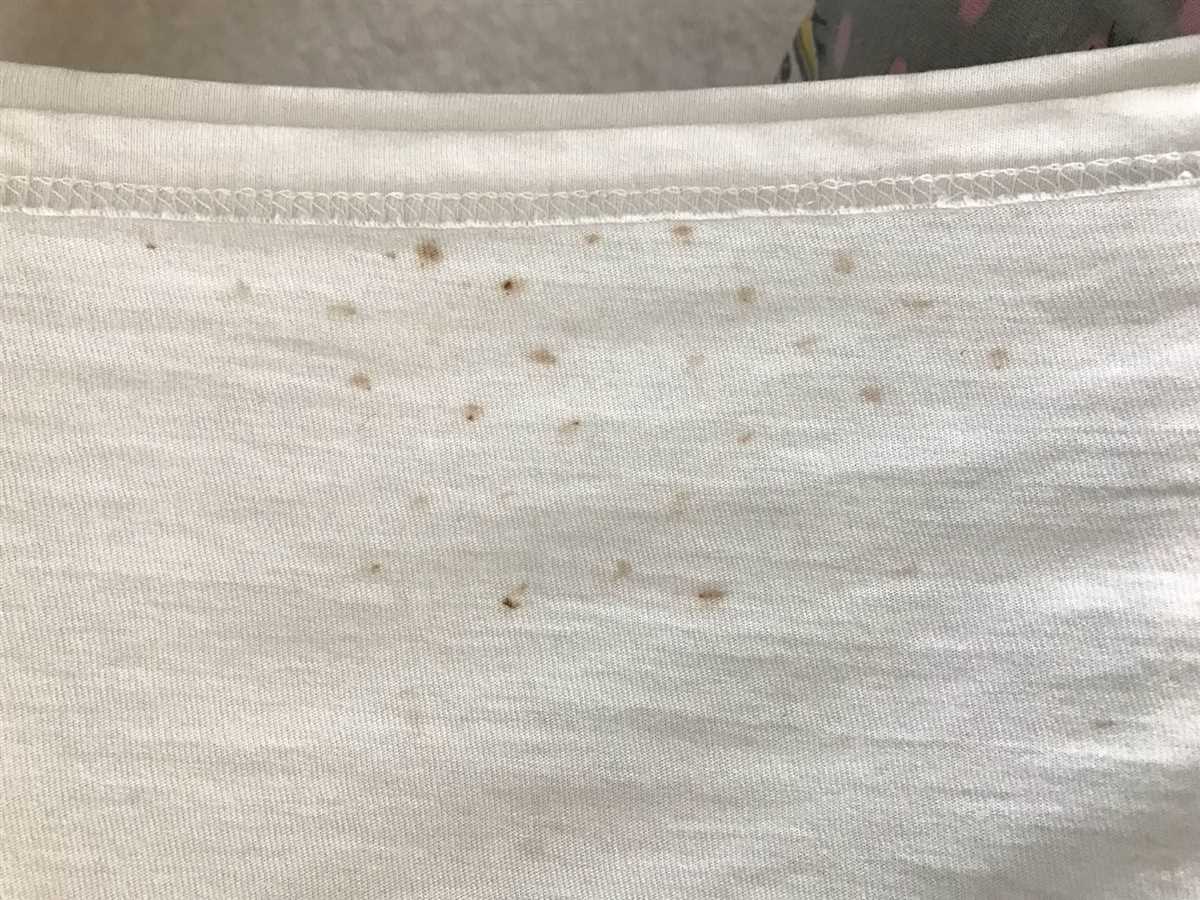
Some stains, especially tough ones like oil or grease stains, may require pre-treatment before washing. If you skip pre-treating these stains, they may not come out completely in the wash and can leave behind residual stains.
Solution: Pre-treat stains by applying a stain remover or laundry detergent directly to the stain before washing. Allow the pre-treatment to sit on the stain for the recommended time before laundering as usual.
6. Washer Malfunction

In some cases, clothes stains after washing may be due to a malfunctioning washer. Issues like clogged drain pumps, worn-out seals, or faulty agitators can contribute to stains on your clothes.
Solution: If you suspect that your washer is malfunctioning, it may be best to call a professional repair service to diagnose and fix the issue. They can inspect and repair any faulty components that may be causing the stains.
By understanding these common reasons for clothes stains after washing, you can take the necessary steps to address the issue and keep your clothes stain-free.
Improper Detergent Usage
Using the wrong detergent or using too much or too little detergent can lead to stains on your clothes after washing. Here are some common issues related to improper detergent usage:
1. Using the wrong detergent
Not all detergents are suitable for every type of fabric. Using the wrong detergent for your clothes can cause stains. It is important to read the labels on both the detergent and your clothing to ensure compatibility. For example, using a detergent designed for colored fabrics on whites can result in residual dye stains.
2. Using too much detergent
Using more detergent than necessary does not necessarily mean cleaner clothes. In fact, excessive detergent can leave residue on your clothes. This residue can trap dirt and other particles, leading to stains. Follow the recommended dosage given on the detergent packaging.
3. Using too little detergent
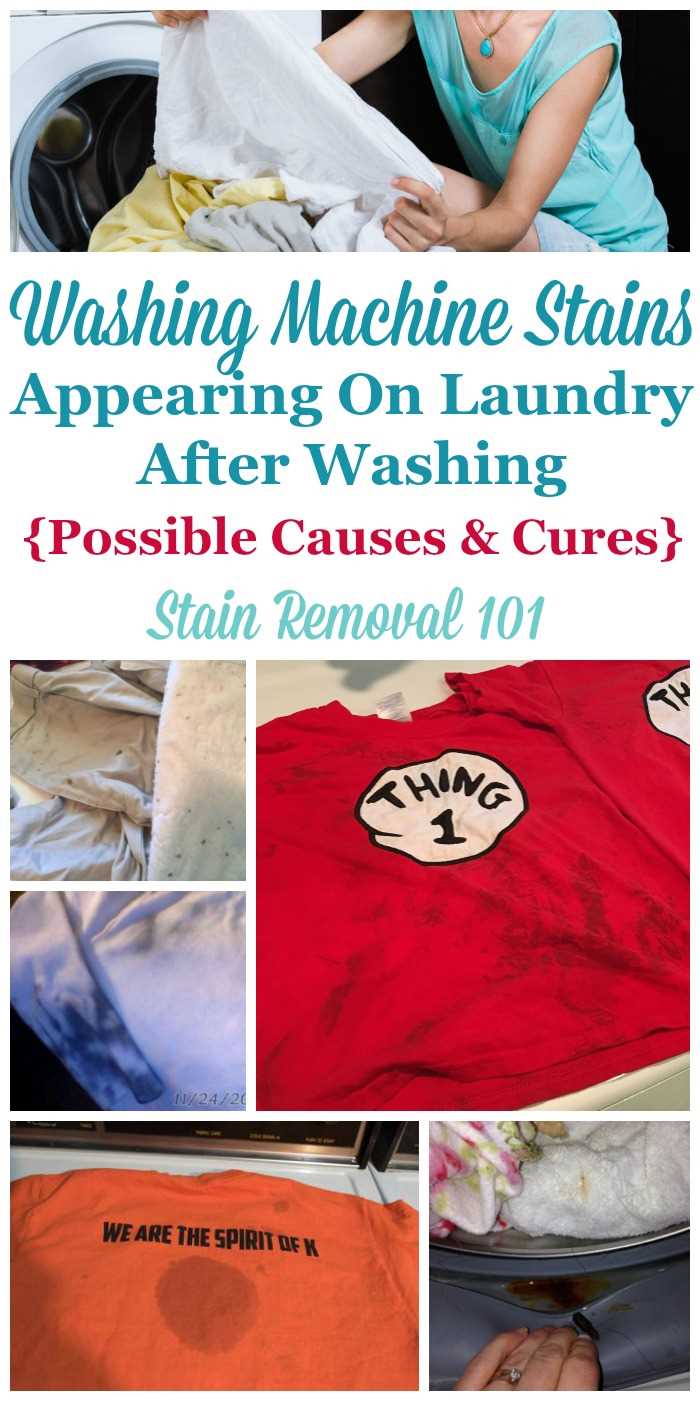
On the other hand, using too little detergent can also result in stains. Insufficient detergent may not be able to fully remove dirt and stains from your clothes. This can lead to visible stains after washing. Again, refer to the instructions on the detergent packaging for the recommended amount to use.
4. Incorrect usage of spot treatments
If you apply spot treatments, such as stain removers, before washing your clothes, make sure to follow the instructions carefully. Some products may require pre-treatment or specific steps that, if not followed properly, can cause stains on your clothes.
5. Not properly dissolving powdered detergent
If you use powdered detergent, it is crucial to dissolve it well in water before adding clothes. Pouring the detergent directly onto clothes can result in undissolved particles sticking to your garments, resulting in stains.
By being mindful of these tips, you can ensure proper detergent usage and minimize the chances of stains appearing on your clothes after washing.
Overloading the Washing Machine
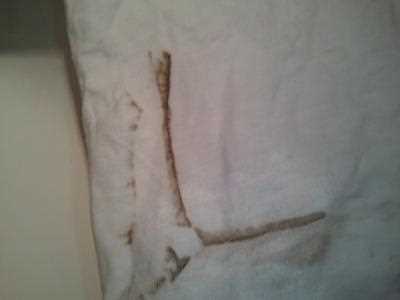
If you notice that your clothes are coming out of the washing machine with stains on them, one possible reason could be that you are overloading the machine. Overloading the washing machine can result in insufficient water and detergent distribution, causing stains to remain on your clothes.
Here are a few things to consider regarding overloading:
- Follow the manufacturer’s guidelines: Each washing machine has a specific capacity that indicates the maximum amount of laundry it can handle. It is important to follow these guidelines to ensure proper cleaning and avoid stains.
- Avoid overcrowding: When loading the washing machine, make sure not to stuff it with too many clothes. Overcrowding can prevent proper agitation and hinder the detergent’s ability to reach all areas of your clothes.
- Leave room for movement: Allow enough room for your clothes to move freely during the wash cycle. This will help promote better cleaning and rinsing, preventing stains caused by clothes rubbing against each other.
When you overload the washing machine, you are essentially compromising its ability to effectively clean your clothes. Insufficient water and detergent distribution can result in stains remaining on your clothes or even transferring from one item to another.
To avoid this problem, make sure to load the washing machine according to its capacity guidelines and leave enough room for your clothes to move freely. This way, you can ensure a thorough and stain-free washing process.
Stained Washer Drum
If you notice stains on your clothes after washing them, the culprit could be a stained washer drum. Over time, dirt, grime, and detergent residue can build up inside the drum, leading to stains on your clothes. Here are some possible causes and solutions for a stained washer drum:
1. Detergent Residue
One common cause of a stained washer drum is detergent residue. When too much detergent is used or not properly dissolved, it can leave behind residue that can stain your clothes. To fix this issue, try the following:
- Use the recommended amount of detergent for your specific machine and load size.
- Make sure to properly dissolve the detergent in the water before adding your clothes.
- Consider using a liquid detergent instead of a powder, as it tends to dissolve better.
2. Mold or Mildew
If your washer drum has a musty smell or visible signs of mold or mildew, it can transfer onto your clothes and cause stains. To address this issue:
- Run a cleaning cycle with hot water and bleach or vinegar to kill any mold or mildew.
- After each wash, leave the washer door open to allow air to circulate and prevent mold growth.
- Regularly clean the detergent dispenser and rubber seal to remove any buildup.
3. Mineral Deposits
Hard water can lead to mineral deposits in your washer drum, resulting in stains on your clothes. Here’s how to tackle this problem:
- Use a descaling agent specifically designed for washing machines to remove mineral deposits.
- Consider installing a water softener or using a water softening product to prevent future mineral buildup.
4. Fabric Softener Stains
If you use fabric softener, excessive use or pouring it directly on your clothes can cause stains. To prevent this:
- Follow the recommended instructions for using fabric softener and avoid pouring it directly on clothing.
- Dilute fabric softener with water before adding it to the washer.
- Consider using dryer sheets instead of liquid fabric softener.
By addressing these potential causes and implementing the suggested solutions, you can help prevent a stained washer drum and keep your clothes clean and stain-free.
Hard Water Issues
Hard water can often be the culprit when it comes to stains on your freshly washed clothes. Hard water contains high amounts of minerals, such as calcium and magnesium, which can leave behind deposits on your fabrics and cause discoloration. Here are a few common hard water issues and how to troubleshoot them:
1. White, Gray, or Yellow Stains
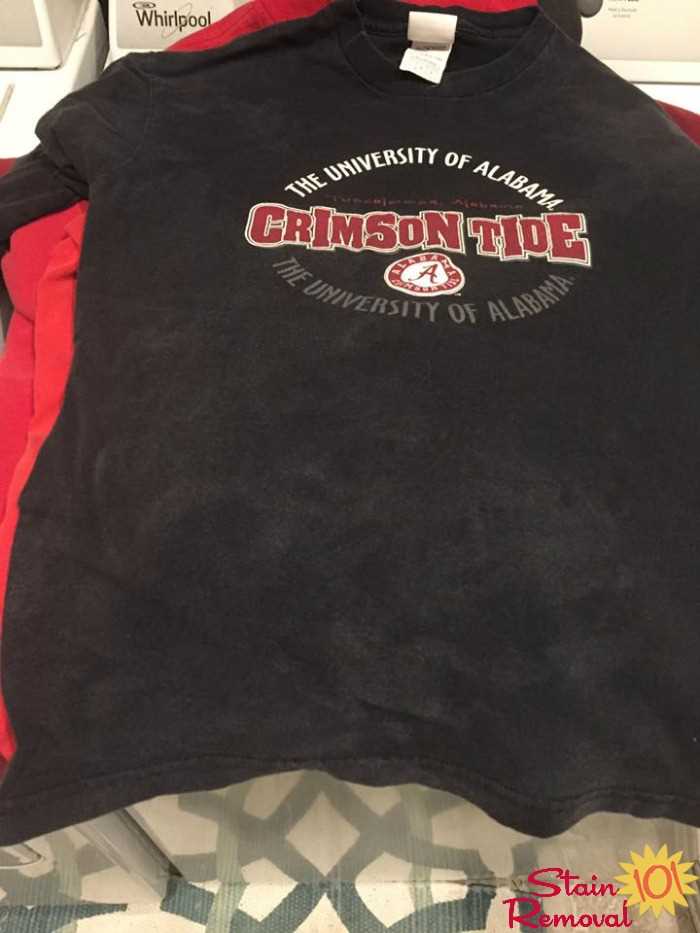
If you notice white, gray, or yellow stains on your clothes after washing, it is likely due to a mineral buildup from hard water. The minerals can leave behind a residue on your clothes, making them look dingy and discolored. Here’s what you can do:
- Consider installing a water softener in your home to reduce the mineral content in your water. This can help prevent future stains on your clothes.
- Use a water conditioner or descaler specifically designed to remove mineral deposits from your washing machine. Follow the manufacturer’s instructions for proper usage.
- Try adding a water softening agent, such as borax or washing soda, to your laundry. These agents can help neutralize the minerals in hard water and prevent stains.
2. Soap Scum Residue
Hard water can also cause soap scum residue to form on your clothes, especially if you’re using too much detergent. The mineral content in hard water can react with the detergent, creating a sticky residue that clings to your fabrics. To tackle soap scum residue:
- Use a smaller amount of detergent when washing your clothes. Check the detergent packaging for guidelines on proper usage based on water hardness.
- Consider using a detergent specifically formulated for hard water. These detergents contain additives that can help mitigate the effects of mineral buildup.
- Regularly clean your washing machine to remove any soap scum residue that may be present. Refer to your machine’s manual for instructions on proper cleaning.
3. Fabric Stiffness
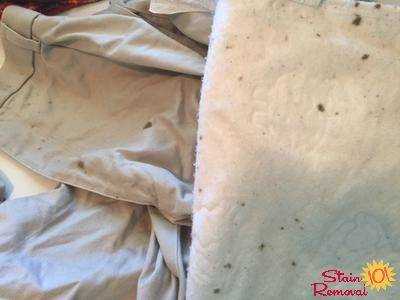
Hard water can make your clothes feel stiff and rough after washing. The minerals in hard water can bind to the fibers of your fabrics, causing them to become stiff and less comfortable to wear. To combat fabric stiffness:
- Add a fabric softener or vinegar to your laundry during the rinse cycle. These additives can help soften the fabric and reduce stiffness.
- Consider using a laundry detergent with built-in fabric softener. These detergents can help reduce fabric stiffness caused by hard water.
- Avoid overloading your washing machine, as this can further contribute to fabric stiffness. Allow enough space for the clothes to move freely during the wash cycle.
By addressing the issues associated with hard water, you can ensure that your clothes come out clean and stain-free after every wash. Experiment with the suggested solutions until you find the method that works best for you.
Malfunctioning or Dirty Dispenser
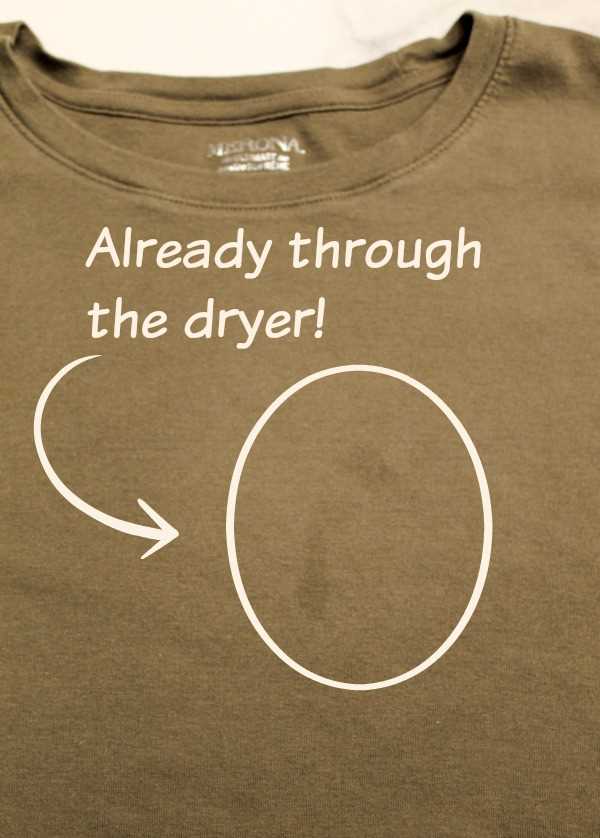
If you notice stains on your clothes after washing them, it could be due to a malfunctioning or dirty detergent dispenser in your washing machine. The detergent dispenser is responsible for releasing the detergent at the right time during the wash cycle, ensuring that it is properly distributed to clean your clothes.
Here are some possible causes and solutions to address a malfunctioning or dirty dispenser:
- Inspect the dispenser tray: Check the dispenser tray for any visible dirt, residue, or clogs. Use a cloth or sponge to clean the dispenser tray and remove any debris that may be affecting the proper flow of detergent.
- Clean the dispenser housing: Remove the detergent dispenser from the washing machine and clean the housing thoroughly. Use a mild detergent or a mixture of vinegar and water to remove any dirt or grime that has accumulated.
- Check for mechanical issues: In some cases, the dispenser may not be functioning correctly due to mechanical issues. If you suspect this is the case, consult the user manual for your washing machine or contact the manufacturer for further assistance.
- Use the right detergent: It’s important to use the appropriate detergent for your washing machine. Using the wrong detergent or using too much detergent can lead to residue buildup and clogs in the dispenser.
- Follow dosage instructions: Make sure you are using the correct dosage of detergent for your load size. Overloading the dispenser with too much detergent can cause it to overflow and result in stains on your clothes.
By regularly cleaning and maintaining the detergent dispenser, you can help prevent stains on your clothes and ensure that your washing machine is functioning properly.
FAQ
Why are my white clothes coming out of the washer with yellow stains on them?
If your white clothes are coming out of the washer with yellow stains on them, it could be due to a few different reasons. First, it’s possible that the detergent you are using is not fully dissolving in the water, and is instead clumping together and leaving behind residue on your clothes. Another possibility is that your washer is not thoroughly rinsing out all of the detergent, bleach, or fabric softener, leaving behind chemical residue that can cause yellow stains. Lastly, if you are using hard water, the minerals in the water can react with the detergent, causing yellow stains. To solve this issue, try using a different detergent, ensuring that it fully dissolves in the water, and using a rinse cycle to thoroughly rinse your clothes.
Why are my clothes coming out of the washer with oily stains on them?
If your clothes are coming out of the washer with oily stains on them, it could be due to a malfunctioning washer. Check the washer’s drum for any traces of grease or oil, as this could be transferring onto your clothes during the wash cycle. Additionally, make sure you are not overloading the washer, as this can prevent proper agitation and result in clothes coming out dirty. If the issue persists, it may be necessary to contact a professional to inspect and repair the washer.
Why are my clothes coming out of the washer with dark spots on them?
If your clothes are coming out of the washer with dark spots on them, it could be due to a few different reasons. First, check the drum of the washer for any dirt or residue buildup that may be transferring onto your clothes during the wash cycle. Clean the drum thoroughly to remove any contaminants. Another possibility is that the detergent you are using is not properly dissolving, resulting in concentrated detergent spots on your clothes. Ensure that you are using the correct amount of detergent for your load size and water hardness. Lastly, if you are using a fabric softener, it may be leaving behind spots on your clothes. Try skipping the fabric softener and see if the dark spots disappear.
Why are my clothes coming out of the washer with blue stains on them?
If your clothes are coming out of the washer with blue stains on them, it is likely that the color from another garment is bleeding onto them during the wash cycle. Check your garments for any items that may be bleeding dye, such as dark denim or new clothing. Separate these items from the rest of the load to prevent further staining. Additionally, make sure you are not overloading the washer, as this can cause garments to rub against each other and increase the likelihood of dye transfer. If the issue persists, consider using a color-catching laundry sheet or pre-treating stains with a stain remover before washing.
Why are my clothes coming out of the washer with white spots on them?
If your clothes are coming out of the washer with white spots on them, it is likely that the detergent you are using is not fully dissolving in the water. This can happen if you are using too much detergent or if the water temperature is too low. Make sure you are using the recommended amount of detergent for your load size and water hardness, and consider increasing the water temperature if possible. It’s also a good idea to add the detergent to the water before adding the clothes to ensure proper dissolving. If the issue persists, try a different brand or type of detergent to see if that resolves the problem.
Why are there yellow stains on my clothes after washing?
Yellow stains on clothes after washing can be caused by a variety of factors. One common cause is using too much detergent, which can leave residue on clothes that then turns yellow. Other possible causes include hard water mineral deposits, detergent not properly dissolving, or dye transfer from other clothing items.















